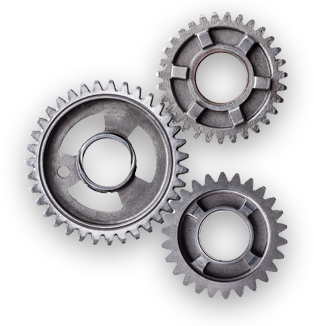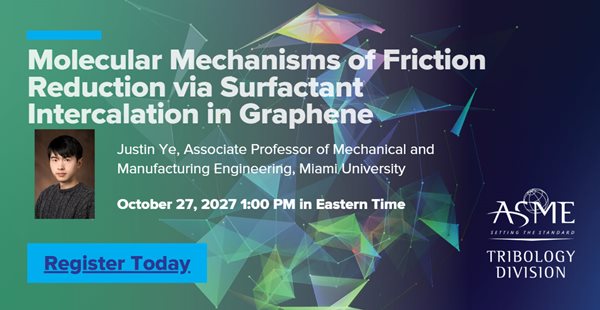Tribology Division
Tribology Division (TRIB) is established to serve the members and associate members of the ASME who have designated their interest in the science & technology of Tribology.

About
The Tribology Division of the American Society of Mechanical Engineers (ASME) is established to serve the members and associate members of the ASME who have designated their interest in the science & technology of Tribology. The field of Tribology includes the analysis of friction, wear, lubrication phenomena and the application of such principles to mechanical design, product development, manufacturing processes & machine operation.
The objectives of the Division, which serve as the basis for its committees, include:
- Gathering & disseminating knowledge in Tribology through all forms of publication
- Organizing knowledge in Tribology for educational purposes
- Exchanging knowledge in Tribology through personal interaction at technical expositions
- Encouraging a cooperative exchange of ideas in Tribology between the industrial & academic communities
- Informing the membership of collaborative opportunities with the international Tribology community
- Publicizing noteworthy accomplishments of the members
- Identifying & promoting opportunities for research & development in Tribology
Events
Upcoming Events:

Molecular Mechanisms of Friction Reduction via Surfactant Intercalation in Graphene
Work by: Justin Ye, Prathima C. Nalam, Deepak Kumar, and Juan Moya
Please register at https://asme.zoom.us/meeting/register/N4qZD-okQty-JxWEqwNxmQ and forward this information to your colleagues. More details regarding the presentation are below.
Presenter Bio: Dr. Justin Ye is an Associate Professor of Mechanical and Manufacturing Engineering at Miami University. He earned his Ph.D. from the University of California, Merced in 2016 under the supervision of Dr. Ashlie Martini. His research in nanoscale tribology integrates advanced simulations and experiments to study friction, wear, and adhesion. His research has been supported by DARPA, NSF, ODHE, and the Lam Research Foundation, etc. and recognized with several honors, including the Lam Research Unlock Ideas Award (2023), the STLE Early Career Award (2022), and Miami University’s Outstanding Faculty Research Award (2021), etc.
More coming soon in the meantime, check out our recorded webinars are available under the Resources Tab.
Honors & Awards
Recognition of outstanding achievement in engineering is one of the major objectives of ASME. Through its programs of honors and awards, ASME recognizes outstanding contributions to the art and science of engineering.
Society Awards
- Mayo D. Hersey Award
Award is bestowed on an individual in recognition of distinguished and continued contributions over a substantial period of time to the advancement of the science and engineering of tribology. - Burt L. Newkirk Award
It is given to one who has made a notable contribution to the field of tribology in research or development as evidenced by important tribology publications. - Marshall B. Peterson Award
The Marshall P. Peterson Award is given biennially in recognition of an early-career achievement and promise for pursuit of research in tribology.
Division Awards
- Journal of Tribology Best Paper Award
- Innovative Research Award
- Timken K.L. Johnson Award
- Seagate Award (Discontinued)
- Donald Wilcock Distinguised Service Award
Important Award Information For Recipients of Monetary Awards
Please note that honorariums cannot be distributed without receipt of applicable tax forms. If you are a recipient of a monetary award, you will be contacted by ASME staff regarding tax forms you will need to complete, as well as how to submit them to us.
Leadership
2024-2025 Division Executive Committee
Chair, Bharat Bhushan
Vice Chair, Farshid Sadeghi, PHD
Secretary, Sriram Sundararajan, Ph.D.
Member, Min Zou
Member, Tevis D. Jacobs
Member, Mr. Nick Weinzapfel
Communications & Outreach, Stefanie Hanke
Special Assignment, Farshid Sadeghi, PHD
Staff Liaison, April Tone - Sr. Manager, TEC Operations
Links
Links to helpful online resources related to the division are below. If you have suggestions for other resources, please contact the division chair or ASME staff.
- ASME Landmarks Program
Landmarks, sites and collections of historic importance to mechanical engineering are designated by ASME through its History and Heritage Landmarks Program. - ASME History and Heritage
ASME fosters the preservation of mechanical engineering innovations used in a wide range of applications through its History and Heritage program.
Other Links of Interest
U.S. Based Organizations
- American Bearing Manufacturers Association (ABMA)
- American Gear Manufacturers Association (AGMA)
- The Society of Tribologists and Lubrication Engineers (STLE)
U.S. Government Agencies and Departments
Others
Publications
- Journal of Tribology
- Facilities Engineerings
- Journal Journal of Testing and Evaluation
- Journal of Metals
- Lube Magazine
Resources
We are committed to organizing education in mechanical engineering surrounding Tribology technical areas. Below is the latest event sponsored by the division.
On the Mercurial Behavior of Ionic Liquids at Sliding Interfaces
by: Filippo Mangolini, The University of Texas at Austin, Austin
Friction and nanoscale wear of stiff multi-contact interfaces (video coming soon)
By: Bart Weber, Advanced Research Center for Nanolithography
"Structural Superlubricity under Ambient Conditions: A Path to Practical Mechanical Systems with Vanishing Friction" presented by: Mehmet Z. Baykara, Department of Mechanical Engineering, University of California Merced, USA
2D MXenes: Tunable Mechanical and Tribological Properties presented by: Andreas Rosenkranz, Department of Chemical Engineering, Biotechnology and Materials, University of Chile, Santiago, Chile
Vehicle Fluids - New Tribology Challenges
By: Dr. Peter Lee, Southwest Research Institute
Nanoparticle suspension for energy efficiency
by: Jacqueline Krim, Physics Department, North Carolina State University
Elucidating the Atomic-scale Mechanisms respobsible for Adhesion, Friction and Tribochemistry using Computer Simulations
by: Dr. Judith A Harrison, U.S. Naval AcademyChallenges and Opportunities for a Sustainable E-Mobility: Recent Progress and Future Prospects
by: Ali Erdemir, J. Mike Walker '66 Department of Mechanical Engineering, Texas A&MStrategies & Approaches for Tribological Phenomena Understanding
by: Sylvie Descartes (Dr. -Ing, HDR)
Lessons from Nature: Bioinspired Mechanically Durable and Self-healing Superliquiphilic/phobic Surfaces
By: Dr. Bharat Bhushan, Tribology Division Chair
Tribology TEC Talk (video viewable by ASME members only)
Tribology TEC Talk Slides
High-Efficiency Low-Tocixity Ionic Liquids as Lubrican Additioves#
Presented by Jun Qui - Materials Science & Technology Division, Oak Ridget National Laboratory
Presentation Slides: ASME-TD-Seminar-2024-1-29
Recent Developments in Synthesis and Process-Structure-Performance Understanding of MoS2 Thin Films
by: Michael T. Dugger, Sandia National Laboratories
Lubrication of Innovative Engineered Bearings and Industrial Motion Components
by: Dr. Ali Erdimir, Professor and Halliburton Chair in Engineering in the Mechanical Engineering Department of Texas A&M University
Seeing the Hidden Interface: Revealing Nanoscale Mechanisms of Contact, Adhesion, and Friction by in situ Experiments
by: R.W. Carpick, Dept. of Mechanical Engineering and Applied Mechanics, University of Pennsylvania
The Tribology of Touch
Cynthia Hipwell, Professor of Mechanical Engineering, Texas A&M University
In-Situ SEM Tribological Testing of 3D-Printed Micro/Nano-Textured Surfaces
by: Mahyar Afshar-Mohajer, University of Arkansas
Tribocorrosion Aspects of Biomedical Implants: Where are we now?
by: Dr. Mathew Mathew, Department of Biomedical Sciences, University of Illinois at Chicago
Electrical Contact and Lubrication
Dr. Robert Jackson, Auburn University
Wear mechanisms or the relations of microstructure and wear in metals
by: Dr. Stefanie Hanke, Tribology Division Secretary
Towards a Predictive Understanding of the Effect of Surface Topography on Surface Properties
By: Tevis D. B. Jacobs
Nature’s Multiscale Design and Smart Manufacturing of Materials
By: Xiaodong (Chris) Li
Molecular dynamics simulations: What are they and why tribologists should care
By: Dr. Ashlie Martini